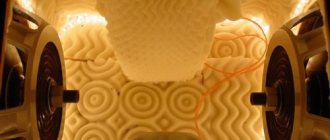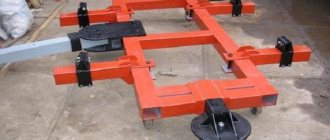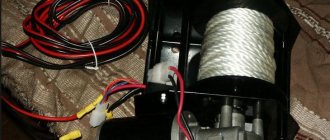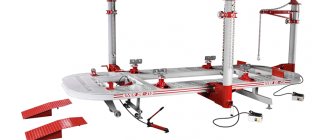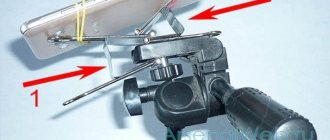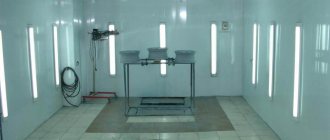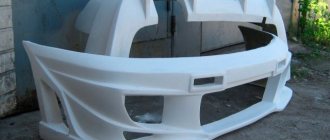The source of powerful low-frequency sound in sound systems is the subwoofer. This also applies to car acoustics, which is why most car enthusiasts equip their cars with such devices.
You can purchase a ready-made unit, but many people prefer to buy speakers and make a box for the subwoofer with their own hands. This is not as difficult a job as it might seem, but it will require tools and certain skills.
How to make a subwoofer box correctly
Before you start making a subwoofer box, you need to choose a loudspeaker. The volume of the future structure will depend on its parameters. Most often, specialized imported loudspeakers with a diameter of 10-12 inches are used to reproduce powerful bass. Structurally, the subwoofer box can be made in three options:
- Closed box
- Bass reflex
- Bandpass
The quality of the loudspeaker and the design of the box ultimately determine the sound quality of the low-frequency sound system.
Types of boxes
There are different types of acoustic design, including:
- Closed.
- Bass reflex.
- Bandpass loudspeaker.
The first types are in great demand because they are easy to build with your own hands. Sound vibrations in such a design are isolated from the environment and damped, creating surround sound. But during the attenuation process, the energy released contributes to heat transfer, which affects the acoustic parameters.
To eliminate this phenomenon, the interior of the box is equipped with soundproofing materials (wool or synthetic padding). As a result, less heat is generated and the speaker sounds more spacious. When tested, this method gives up to 15-20% increase in volume.
Despite the ease of manufacture, such a box for a subwoofer has a lot of advantages. The first is the ability to quickly calculate the volume of the box. The second is the minimum probability of speaker overload. The third is the lack of competitors in sound quality when choosing a suitable subwoofer head and proper design of the housing.
How to make a housing for a subwoofer
The easiest to make is a buried box or box. This is a completely closed structure, the manufacture of which will require a minimum of simple wooden parts. How to make a housing for a sub becomes clear when you see such a device. Essentially, this is a rectangular box with a hole cut out in the front wall for a dynamic head. The box consists of six walls, which are easy to cut out of the appropriate material. A terminal block is mounted on the side or rear wall to connect wires from the amplifier. The closed box (CB) is distinguished by dense and not vague bass, smooth amplitude-frequency response, but has the lowest efficiency among all designs.
The box can be in the shape of a parallelepiped or trapezoid with beveled walls. Due to its characteristics, the closed design is suitable for many musical styles. The sealed, closed design conveys bass well in pop and rock music, classical, jazz and instrumental works. But fans of rap and dubstep will be disappointed, as the closed box is not suitable for playing music that has a lot of heavy bass and where the low frequencies are the basis of the music.
How to properly assemble a subwoofer enclosure
It is not difficult to make a housing for a subwoofer with your own hands if you strictly follow all the recommendations. The most important thing that a closed case requires is tightness and lack of vibration. The optimal material for a low-frequency speaker is multilayer plywood or MDF. The thickness of the material must be at least 18-20 mm. Thin walls will resonate and these vibration waves entering the car interior will greatly degrade the quality of low frequency reproduction. The most important parameter of any subwoofer is its volume. This parameter takes into account the internal space of the box without the volume occupied by the speaker. The relationship between the volume of the housing and the diameter of the loudspeaker is as follows:
- 10 inches (25 cm) – 15-20 liters
- 12 inches (30 cm) – 25-35 liters
- 15 inches (35 cm) – 40-60 liters
- 18 inches (46 cm) – 70-110 liters
In order to increase efficiency and improve sound quality, all seams between wooden walls must be sealed. It is best to use silicone sealant for this purpose. A closed box for a subwoofer, made with your own hands, has its undoubted advantages:
- Easy to calculate volume
- Ease of production
- Small sizes
- Distinct and clean bass
There are only two main disadvantages: low efficiency, not suitable for listening to “heavy” bass. The internal volume of a closed subwoofer can be filled with padding polyester or cotton wool. If the volume is calculated correctly, then this is not necessary. It is recommended to listen to the work of the subwoofer, both with and without filler, and choose the best option. At different air temperatures, the pressure inside a closed volume changes and to equalize it, a small hole of no more than 1.5-2.0 mm is sometimes left in the subwoofer housing.
Bass reflex
This type of design is quite more difficult to calculate and build. Its design is significantly different from a closed box. However, it has advantages, namely:
- High level of efficiency. A bass reflex will produce low frequencies much louder than a closed box;
- Simple calculation of the body;
- Reconfiguration if necessary. This is especially important for beginners;
- Good speaker cooling.
The bass reflex also has disadvantages, the number of which is greater than that of the ZYa. So, the cons:
- FI is louder than ZY, but the bass here is not so clear and fast;
- The dimensions of the FI box are much larger compared to the ZY;
- Large displacement. Because of this, the finished box will take up more space in the trunk.
Based on the advantages and disadvantages, you can understand where FI boxes are used. Most often they are used in installations where loud and pronounced bass is needed. The bass reflex is suitable for listeners of any rap, electronic and club music. It is also suitable for those who do not need free space in the trunk, since the box will occupy almost all the space.
The FI box will help you get more bass than from a small-diameter speaker. However, this will require much more space.
What volume of box is required for a bass reflex?
- for a subwoofer with a diameter of 8 inches (20 cm) you will need 20-33 liters of net volume;
- for a 10-inch speaker (25 cm) – 34-46 liters,
- for 12-inch (30 cm) – 47-78 liters,
- for 15-inch (38 cm) – 79-120 liters
- and for an 18-inch subwoofer (46 cm) you need 120-170 liters.
As with ZY, the numbers given here are imprecise. However, in a FI case you can “play” with the volume and take a value less than recommended, finding out at what volume the subwoofer plays better. But do not increase or decrease the volume too much, this can lead to loss of power and failure of the speaker. It is best to rely on the recommendations of the subwoofer manufacturer.
What does the FI box setting depend on?
The larger the volume of the box, the lower the tuning frequency, the bass speed decreases. If a higher frequency is needed, then the volume must be reduced. If your amplifier's rated power exceeds the speaker's rating, then it is recommended to make the volume smaller. This is necessary in order to distribute the load on the speaker and prevent it from exceeding the stroke. If the amplifier is weaker than the speaker, then we recommend making the volume of the box a little larger. This compensates for the volume due to the lack of power.
The port area should also depend on the volume. The average speaker port area values are as follows:
for an 8-inch subwoofer you will need 60-115 sq.cm,
for 10-inch – 100-160 sq.cm,
for 12-inch – 140-270 sq.cm,
for 15-inch – 240-420 sq.cm,
for 18-inch - 360-580 sq.cm.
The length of the port also affects the tuning frequency of the subwoofer box; the longer the port, the lower the box tuning; the shorter the port, the higher the tuning frequency. When calculating a box for a subwoofer, first of all, you need to familiarize yourself with the characteristics of the speaker and the recommended parameters of the housing. In some cases, the manufacturer recommends completely different box parameters than those given in the article. The speaker may have non-standard characteristics, causing it to require a specific box. Such subwoofers are most often found from manufacturing companies Kicker and DD. However, other manufacturers also have such speakers, but in much smaller quantities.
The volumes are approximate, from start to finish. It will differ depending on the speaker, but as a rule they will be in the same plug... For example, for a 12-inch subwoofer it is 47-78 liters and the port will be from 140 to 270 sq. cm, but how to calculate the volume in more detail, we will learn all this in subsequent articles. We hope that this article answered your question, if you have comments or suggestions, you can leave your comment below.
The information you learned is perfect for those who want to learn how to count boxes on their own.
Making a box for a subwoofer with your own hands
Making a do-it-yourself subwoofer housing is simple and takes a minimum of time. After the speaker has been selected and the internal volume of the closed box has been calculated, you need to prepare the material, fasteners and tools. With your own hands, the subwoofer body is usually made from the following materials:
- Plywood
- MDF
- Chipboard
Moisture-resistant multilayer plywood is considered the best material for making a subwoofer box. There are some difficulties with this. Plywood is the most expensive material and it is difficult to find plywood with a thickness of 18 mm or more. If the volume of the subwoofer is too large, then the plywood walls will emit a “ringing”, which can be eliminated by installing internal stiffeners. A good choice would be to use MDF. It is cheaper than plywood, easy to process and has good moisture resistance. Chipboard has become widespread. It can be found at any furniture company. There the slab will be cut to the specified dimensions. The disadvantages of chipboard structures include very low rigidity, when strong low-frequency vibration at the fastening points causes the material to collapse. In addition, it absorbs moisture well and if water gets into the trunk of a car, the box may simply crumble. This material can be used to make a housing for a home subwoofer. It will not be used in extreme conditions and will last a long time.
How to increase the rigidity of the box?
- The first, the simplest and most obvious. This is the thickness of the material, the thicker the material, the greater the rigidity. When making a subwoofer, we recommend using materials of at least 18 mm, this is the golden mean. If your subwoofer has a power of more than 1500w RMS, then it would not be superfluous to choose a material thickness of 20 mm or more. If you have difficulty finding thick-walled materials, you can use the following recommendations.
- An option that will add rigidity to your box is to make a double front wall. That is, the front part in which the speaker is installed. This part of the subwoofer is most subject to stress during operation. Therefore, having a material width of 18 mm, making the front wall double we get 36 mm. This step will significantly add rigidity to the box. You should also do this provided that your subwoofer has an RMS (rated power) of more than 1500w. If you have a subwoofer with a lower power, for example, 700w, the front wall can also be made double. This makes sense, although the effect will not be very large.
- Another tip is to use spacers inside the subwoofer to add extra rigidity. This works especially well when the subwoofer has a large volume. Let's say you have two 12-inch subwoofers (speakers) in a box. In the middle, the rigidity of the box will be the smallest due to the large area. In this case, it would not hurt you to strengthen the structure and install a spacer in this place.
That's all we wanted to tell you about materials for the subwoofer. If this article helped you, please rate it out of five below.
Do you want to try to calculate the box yourself? Our article “Learning to count a subwoofer box” will help you with this.
The right subwoofer box
The correct body means a more complex, but also higher quality design. This could be a body with a bass reflex or an even more complex system called a bandpass. Assembling a subwoofer enclosure with your own hands will take more time, but the result is worth it. The bass reflex can be slotted or in the form of a pipe. This design is a small “tunnel”. It rotates or inverts the phase of the signal with its further radiation into space, as a result of which the efficiency of the subwoofer doubles. A bass-reflex subwoofer is distinguished by strong and rich bass, and on its amplitude-frequency characteristic, at the tuning point, there is a large protrusion and At this frequency the volume increases. The tuning peak is regulated by changing the size of the port and the ratio of the working volume of the subwoofer to the size of the bass reflex. This subwoofer design is well suited for playing music with fast and powerful lows. How to assemble a subwoofer box largely depends on its design.
Calculation of housing for a 12-inch subwoofer
First of all, you need to choose the type of enclosure. What volume is needed for a 12 subwoofer. For a 30 cm loudspeaker, the volume of a closed box should be about 32 liters, but not more than 40. For a bass reflex design, twice the volume will be required. A small box for subwoofer 12 can be made from MDF. The material must be chosen unpainted and without plastic coating. The minimum volume of a closed box for a subwoofer is 22 liters. If wooden elements are cut out by hand, then during assembly the seams must be coated with any “liquid nails”. When cutting the material by hand, the seams are uneven, and the filler will seal the joints. When cutting on a machine, this is not necessary. The correct box for a 12-inch subwoofer will only be obtained if all dimensions are strictly observed.
How to calculate a box for a subwoofer 12. To calculate the volume, there is a simple “school” formula, where the volume is equal to the product of the length, width and height of a rectangular box or V=L*X*Y, where L, X and Y height are width and depth. Since the subwoofer is most often installed in the trunk, knowing the maximum allowable height and the required volume for a particular speaker, it is easy to calculate the width of the front wall and the depth of the front wall for a 12-inch subwoofer. You can make a case for a 12-inch subwoofer with an inclined front wall, but its calculation will be more complex. To perform all calculations related to the design of a subwoofer, there are online programs. A convenient calculator is Subbox.pro. The program offers several subwoofer design options, including closed box, slot or tubular bass reflex. Unlike the online program, BlauBox and PerfectBox 4.5 need to be downloaded. These products are universal and accurate, but do not have a Russian-language interface, and it will be difficult for an untrained amateur to understand them.
Making a housing for a subwoofer with a bass reflex
As with making a closed box, work on a more complex design begins with choosing a loudspeaker. How to make a box for a subwoofer depends on the type of material and fasteners. Multi-layer plywood is the strongest recommended material. To assemble the subwoofer housing with your own hands, you can use any self-tapping screws. When connecting elements from MDF, and especially from chipboard, you need to use only white self-tapping screws. Black ones do not provide such a strong connection. Sometimes the caps break off when screwed in.
The bass reflex subwoofer must be well sealed. To do this, a layer of sealant is applied to all seams on the inside. The cutting lines must be very even, so it is better to do the work on a special machine, if possible.
When making a slotted bass reflex, you need to ensure that all internal partitions do not have through holes. If the dimensions of the speaker and the box are large, then stagnant zones may appear in the turns of the slot port. To avoid this, all right angles of the bass reflex are smoothed out by installing additional wooden plates. Do-it-yourself subwoofer box assembly is completed by installing external contacts for connecting the amplifier. These places must also be sealed.
Small subwoofer box
Some motorists do not strive for powerful bass, but want to slightly improve the sound picture in the cabin. A small subwoofer is suitable for this. 8" speakers are suitable for this design. Some companies make 6-inch speakers, but they are hard to find. How to make a subwoofer box correctly. A subwoofer for a small loudspeaker has a small displacement, therefore, it will take up little space in the luggage compartment of the car. There is no need to reduce the size of the structure too much, but you also shouldn’t increase it. Increasing the size of the box will lead to the fact that low frequencies will “spread” and the bass will be unclear. If the volume is less than what is needed for a speaker of a certain diameter, then the lows will be too fast and will literally hit the eardrums.
How to make a housing for a subwoofer with your own hands
If you need to make a good box for a subwoofer, then it is best to focus on the most complex design. This system is called a bandpass. It comes in fourth order and sixth order. The fourth-order system is a two-chamber box, where one chamber is a closed box, and the other plays the role of a bass reflex.
A sixth-order bandpass is a design with two bass reflexes. The most difficult thing here is the calculation of the second port and the relative relationship of the settings of each bass reflex. The two chambers have different sizes and are capable of limiting the frequencies reproduced by the loudspeaker. The box for two subwoofers is the most difficult to design, but it has the maximum efficiency. To determine all sizes of such sound systems, special utilities are used. The universal WinISD program is suitable for calculating any subwoofer design. It does not have a Russian-language interface, but it is not difficult to understand. To make a drawing of a box for a subwoofer, just load the parameters of the speaker you are using into your computer.
Subwoofer housing drawings
If you don’t have the time and desire to calculate the subwoofer box yourself, you can take ready-made calculations and drawings. If you need to make the bass very deep and powerful, you can make a subwoofer box for two speakers. In this case, the design can be in the form of a closed box or bass reflex. Both speakers must be of the same type and with the same resonance frequency, otherwise it will be difficult to adjust the bass reflex. If you have no experience working with car acoustics, then it is better to make your first subwoofer using a closed box design. A bass reflex subwoofer with one loudspeaker is also easy to make with your own hands. You should not, without experience, take on a system such as a bandpass. In any case, the result will not be satisfactory.
Preparation
To make a subwoofer enclosure yourself you will need:
- Drawing;
- Materials: plywood or MDF, glue, screws, terminal block, wire for connection;
- Tools - jigsaw, screwdriver, pencil, template for mounting hole or compass.
Drawing
Having the housing parameters for the subwoofer in hand (volume, area and length of the port), you can make a drawing yourself using special programs (in my opinion, SketchUp from Google is the most convenient for this). But if you make the box for yourself, then there is no point in wasting time learning the software and doing everything the old fashioned way - by hand.
If you do not know how to calculate the enclosure, then read the material “How to calculate the enclosure for a subwoofer.” You can also order a paid estimate on the Internet; as a rule, it is accompanied by a clear drawing for manufacturing.
An example of a drawing of a housing with a bass reflex (FI)
Materials and fasteners
Housing material
In order to make a box for a subwoofer, you need a material that should vibrate as little as possible. From experience, it is best to use MDF (not painted, not laminated, etc.)
MDF (MDF - Medium Density Fiberboard). In Russian - medium density fiberboard.
MDF is easy to process, has good density, due to its structure it has no resonances and does not delaminate - the bass in such a box is soft and dense. MDF is more expensive than plywood and is “afraid” of moisture.
Plywood is the most common option and costs less than MDF.
Do not use chipboard or old furniture to make subwoofer boxes. A plywood or MDF body will always sound better.
If the walls are thick enough, there is no need to cover the inside of the body with vibration insulation, etc.!
Do not use material thinner than 18 mm. and the larger the volume of your case, the thicker the walls should be.
Many large stores that sell sheet material offer a cutting service to your dimensions, where they will cut the perfect parts for you on a machine, all that remains is to assemble the body.
Fasteners
For fastening, it is best to use yellow self-tapping screws with a length at least 2 times the wall thickness. The heads of black ones often break off; they are thinner and not as strong. An advanced solution is furniture bolts, but if this is your first sub, then it will be easier with self-tapping screws.
